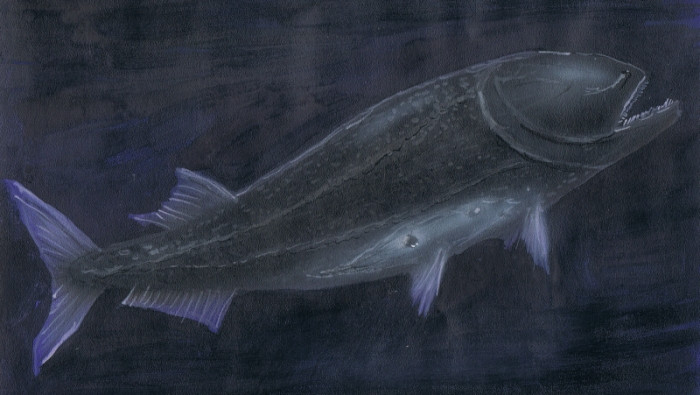HOME | DD
 AlexSone — Ichthyophyseter from neocene
AlexSone — Ichthyophyseter from neocene

Published: 2010-11-18 20:40:35 +0000 UTC; Views: 4049; Favourites: 62; Downloads: 18
Redirect to original
Description
Ichthyophyseter, cachalote fish (Ichthyophyseter theutiphagus)Order: Tarpons (Elopiformes)
Family: Cachalote fishes (Ichthyophyseteridae)
Habitat: temperate and cold waters of all oceans, depths from 100 up to 2000 meters. At night individuals from the populations living in the top layers of ocean may rise almost to water surface.
Overhunting and pollution of ocean had resulted in sharp decrease of number of cetacean population, including odontocetes feeding at the great depths – sperm and bottlenosed whales. Populations of these animals appeared too small in order to restore the species of these mammals in former number. This event had resulted in growth of number of cephalopods – the basic prey of these whales. In early Neocene squids had made serious attempt to press fishes in habitats of open ocean. They had occupied ecological niches of medium-sized predators, and some of them became very large animals. To reply to the burst of number and variety of squids among fishes the species capable to compete to them, and even to attack squids began to evolve. Among them false swordfishes, capable to catch up even the fastest squids, had appeared. And other species had staked on strenght and had turned to specialists in large squid hunting. The cachalote shark (Physelache planicephala) from Northern Atlantic and also cosmopolitic mesopelagic cachalote fish, or ichthyophyseter, belong to such species. It descends from one species of tarpons (Megalops) – representative of low-specialized group of osseous fishes. Due to unpretentiousness and ability to live in water of various degrees of salinity tarpons managed to survive in epoch of anthropogenous pressure, and after human disappearance had made a number of successful attempts to manage pelagic habit of life.
The body length of this species is up to 6 – 7 meters; it is one of the largest osseous fishes of Neocene. The body of ichthyophyseter has a shape typical for tarpon fishes – fish resembles huge herring with disproportionately large head reaching the one fifth of a body length of fish.
Ichthyophyseter is bad swimmer. This fish is able to do short fast throws but swimming to long distances is an excessive task for this predator. Unpaired fins of this fish are shifted back. Back fin is pointed, and tail fin is wide and forked. Body is covered with tiny scales deeply immersed in skin. Because of it the skin of fish seems rough to the touch. Skin has dark grey color; fins are transparent. Peritoneum is also transparent, and swallowed prey is visible through walls of stomach.
Muscles of ichthyophyseter are rather flabby and soft. The most part of time fish passively floats in water due to fat with which its muscles and skeleton are impregnated. Eyes of ichthyophyseter are completely reduced. Even traces do not remain from them; the optic nerve is also reduced. In life of fish sight is functionally replaced with seismosensoric feeling: at ichthyophyseter bodies of lateral line are well advanced. They form dense circuit on head and the dual lateral line along the body. Sense of smell of ichthyophyseter is also very keen. Large nostrils have the unusual shape – they are extended to long grooves, are arch-like bent upwards and stretch from tip of muzzle up to the place of former eye-sockets.
Teeth of ichthyophyseter are numerous and similar to nails – they are very thin and long. Some hundreds teeth grow not only at the edges of jaws, but also on the palatal bones and on edges of tongue. Small peaked teeth also cover a surface of tongue. The main task of such teeth is not to cut flesh, but to keep slippery and flabby body of squid – the basic prey of ichthyophyseter.
This species lives mainly in depths of ocean. In Atlantic ichthyophyseter competes to cachalote shark and consequently keeps in depths. In other parts of area this fish frequently rises to the top layers of water, and it happens, that the heavy gale casts such fishes ashore.
As a meeting of such fishes in depths is rather rare event, in breeding physiology of ichthyophyseter the essential changes take place. This species is hermaphroditic; each individual is capable to produce simultaneously male and female sexual products. Fertilization is carried out with the help of cloaca capable to turn outside. Self-fertilization is possible only in extreme cases, and usually two sexually mature individuals mutually fertilize each other. Sperm is kept viable for a long time in distal part of ovoduct. At the moment of egg spawning spermatozoids leave in water, turn more active and fertilize eggs. Eggs are spawned as a long slimy cord that facilitates care of posterity: fish at once takes the fertilized eggs in mouth and bears clutch within several days. Spawning takes place repeatedly within one year.
The characteristic for tarpons leptocephalus larva of prolonged leaf-like shape hatches from egg. It leads pelagic way of life and has well advanced eyes and wide mouth with pointed teeth. Leptocephali of ichthyophyseter live in top layer of water and eat young ones of other species of fishes and pelagic invertebrates. Cannibalism is also characteristic for them. At the length of about 4 – 5 cm metamorphosis begins: the reduction of eyes and increase of mouth take place, body turns narrower and shorter. Fry of ichthyophyseter lives at the depths of 30 – 50 meters and eats mainly crustaceans and small fishes. As fish grows, the reduction of eyes proceeds further and fish passes to life in depth. Its diet changes, and it passes to feeding on cephalopods. At the age of five years it reaches the length of two meters, and fish grows up to maximal size at the age of twenty years. Life expectancy of ichthyophyseter reaches 60 – 70 years.



























